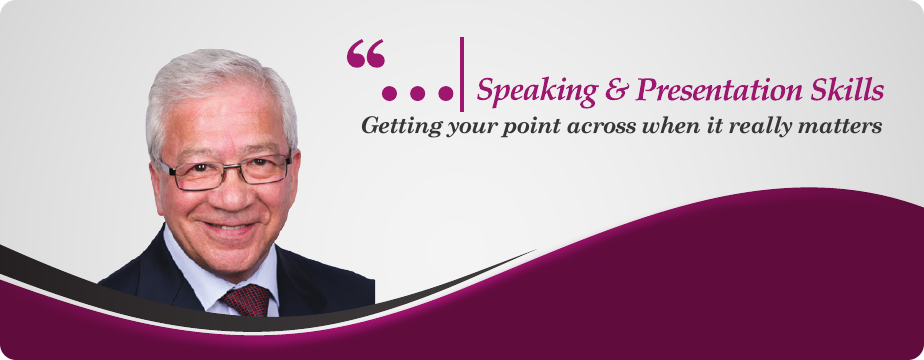The language of a speech or presentation
Every once in a while I come across a phrase that says exactly what I have in mind, with all the economy and beauty of poetry, and if it comes from someone else, I borrow it — but acknowledge the source. For example Peggy Noonan, speechwriter to US Presidents, once said,
“You must be able to say the sentences you write.”
So simple, yet so profound. If you remember that sentence every time you sit down to write a speech or presentation, you’ll make a big improvement.
My own aphorism on the subject goes like this: “The text that’s written to be said is different from the text that’s written to be read.” So write for the ear.
Language
The text for a speech should have these 7 characteristics, if it is to work as the vehicle for your thoughts and ideas:
1. It must be your own
2. It must be easy to speak
3. It must be easy to understand
4. It must make mental pictures
5. It must have energy
6. It must contain memorable phrases
7. It must have rhythm
I shall deal with the last item on another occasion, but let’s tackle each of the other points as they fall.
1. Make it your own
Your speech must be as close as possible to your normal conversational style, minus the verbal crutches, slang and swearing that might pepper your conversation with mates in the pub. Otherwise it will sound unnatural, you will not be comfortable, and your audience will stop listening to you.
2. Make it easy to speak
Think about Peggy Noonan’s statement that you must be able to say the sentences you write. Try saying this sentence out loud:
If you are faced with a potentially hostile audience, and if it is appropriate, ask the person who invited you to indicate the audience’s opinion of you and your topic, as well as the names of any especially troublesome participants.
The individual words are not unusual, but the way they are grouped together makes the sentence unwieldy. Also, the meaning is unclear.
3. Make it easy to understand
Remember, you will be speaking at 120-150 words a minute, or so, having thought out what you want to say. Your audience will hear your words just once. At 120-150 words a minute. Every minute. On and on. Until you stop. It’s hard work being an audience! So why not meet them halfway and make it easy to understand what you are driving at?
4, Make mental pictures
Avoid negative phrasing and abstract terms. They do not make pictures in the minds of your listeners.
Consider the difference between these two:
He was always busy, persistently acquiring knowledge and modifying his behaviour according to the mores of each new discipline, and benefiting from them in the process.
and
Like a tireless bumble bee sipping nectar from flower after flower, he soaked up knowledge from every possible source, growing and developing as he did so.
5. Give it energy
Since the purpose of your speech must be to bring about change in the thinking, attitude or behaviour of your listeners, you must be persuasive, and that can only be achieved if you speak with energy. Your choice of words must reflect that energy. You cannot expect to achieve your purpose if your words imply, “Here it is. Take it or leave it.”
6. Deliver memorable phrases
We live in the age of the sound bite: a 12-second statement that summarises or encapsulates a major statement. The listening public expects pithy, memorable phrases that work almost like slogans. Advertising copywriters have recognised this trend, and they create brand awareness through memorable (if sometimes meaningless) slogans.
- A Mars a day helps you work, rest and play
- Go to work on an egg
- It’s good to talk
- Beware of Jeep imitations
Politicians’ speechwriters are strong on memorable catchphrases such as:
- The pound in your pocket
- You’ve never had it so good
- This lady’s not for turning
In summary, make your text easy to say and easy on the ear, with word pictures and some memorable phrases.
Filed under: copywriting, Presentations, public speaking, Writing


